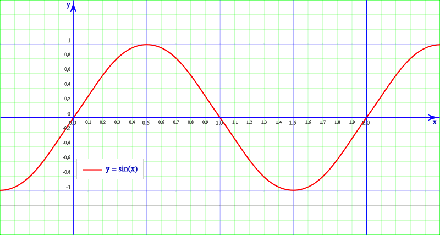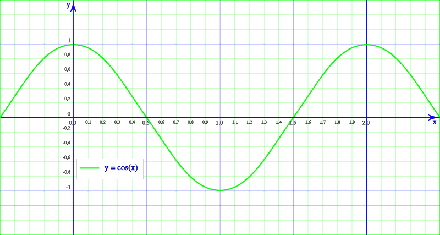The sine function, $$sin(x)$$

- Domain: $$\mathbb{R}$$
- Image: $$[-1,1]$$
- Period: $$2\pi$$ rad
- Continuity: It is continuous on $$\mathbb{R }$$
- Increasing on: $$\ldots \cup \Big(\displaystyle -\frac{\pi}{2}, \frac{\pi}{2}\Big) \cup \Big(\displaystyle \frac{3\pi}{2}, \frac{5\pi}{2}\Big)\cup \ldots$$
- Decreasing on: $$\ldots \cup \Big(\displaystyle \frac{\pi}{2}, \frac{3\pi}{2}\Big) \cup \Big(\displaystyle \frac{5\pi}{2}, \frac{7\pi}{2}\Big)\cup \ldots$$
- Maxima at: $$\Big\{ \displaystyle \frac{\pi}{2}+2\pi\cdot k$$, $$k \in \mathbb{Z}\Big\}$$
- Minima at: $$\Big\{ \displaystyle \frac{3\pi}{2}+2\pi\cdot k$$, $$k \in \mathbb{Z}\Big\}$$
- Parity: Odd, $$\sin x=-\sin (-x)$$
- Points of intersection with the axis Ox: $$x=k\cdot \pi$$, $$k \in \mathbb{Z}$$
The cosine function, $$cos(x)$$

- Domain: $$\mathbb{R}$$
- Image: $$[-1,1]$$
- Period: $$2\pi$$ rad
- Continuity: It is continuous on $$\mathbb{R }$$
- Increasing on: $$\ldots \cup (-\pi,0) \cup (\pi,2\pi) \cup \ldots$$
- Decreasing on: $$\ldots \cup (0,\pi) \cup (2\pi,3\pi) \cup \ldots$$
- Maxima at: $$\Big\{ 2\pi\cdot k$$, $$k \in \mathbb{Z}\Big\}$$
- Minima at: $$\Big\{ \pi\cdot (2k+1)$$, $$k \in \mathbb{Z}\Big\}$$
- Parity: Pair $$\cos x = \cos (-x)$$
- Points of intersection with the axis Ox: $$x=\displaystyle \frac{\pi}{2}+k \cdot \pi$$, $$k \in \mathbb{Z}$$
The tangent function, $$tan(x)$$

- Domain: $$\mathbb{R}-\Big\{ (2k+1) \cdot \displaystyle \frac{\pi}{2}, k \in \mathbb{Z}\Big\}=\mathbb{R}- \Big\{ \ldots, \displaystyle -\frac{\pi}{2},\frac{\pi}{2}, \frac{3\pi}{2}, \ldots \Big\}$$
- Image: $$\mathbb{R}$$
- Period: $$\pi$$ rad
- Continuity: It is continuous on $$\mathbb{R}-\Big\{\displaystyle \frac{\pi}{2}+k\pi, k \in \mathbb{Z} \Big\}$$
- Increasing on: $$\mathbb{R}$$
- Maxima: No maxima
- Minima: No minima
- Parity: Odd $$\tan x = - \tan (-x)$$
- Points of intersection with the axis Ox: $$x=k\cdot \pi, k \in \mathbb{Z}$$
